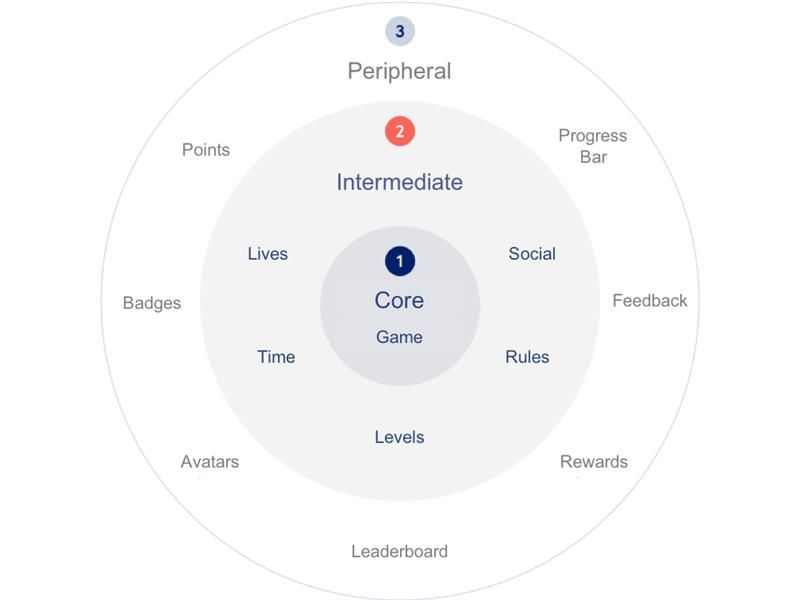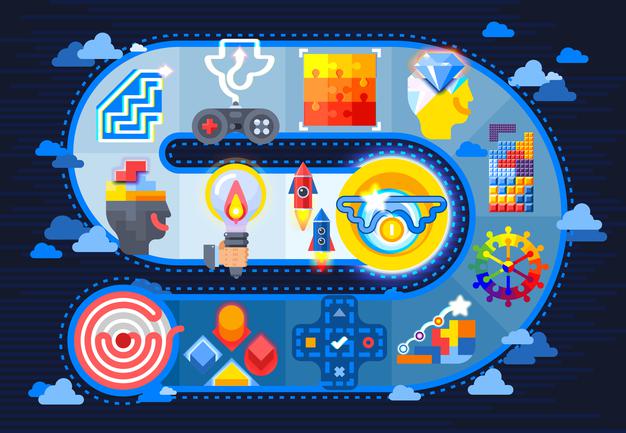When we talk to our customers – business leaders and HR executives – we often hear about the fatigue that training programs bring to frontline sales reps as programs get viewed as an additional ‘task’ versus as an enabler to the existing ‘tasks’ at hand.
As a means to help the frontline teams ‘switch off’ from their work, but still get learning content that is personalized for their role, gamification of learning has proven to be a very effective approach.
But has gamification affected or created a major sense of accomplishment among end users, much like completing a world in Super Mario Brothers would, or a challenging Mortal Kombat round will elicit?
Gamification has of late become an overused word that has influenced several industries and disrupted traditional business workflows. As with any relatively new technology or approach, it’s important to sift through the noise and identify what are different types of gamification.

Gamification Type 1: Peripheral - Points, Badges & Leaderboard
When we view various business applications, the most common manifestation of gamification tends to be incorporating points, awarding badges, and showcasing leaderboards. The PBL (or Points, Badges, and Leaderboards) phenomenon has hit many industries and business applications – from travel and food apps to SaaS-based applications like CRMs, Collaboration tools, etc. Using new-age gamification tools that focus purely on the PBL approach gives you the chance to set up leaderboards and various kinds of rewarding sales games and contests. The key focus of these tools is to have a well-defined points-per-metric system that incentivizes the KPIs. This helps to empower frontline teams and serves as a key reinforcement method.
While PBLs are essential to a gamification approach and can often be the easiest aspect of game mechanics to include, they aren’t comprehensive. It’s little wonder then that even after incorporating great animations and user experience, the fundamental incorporation of PBLs does little on their own to drive user behavior.
When we think of the elements of gamification, PBLs can be thoughts of as the peripheral aspects of gamification. By peripheral, we mean easiest to implement and most applicable across a broad spectrum of industries and business processes. So sales teams can incorporate PBLs to drive their CRM usage much as logistics & delivery firms can incorporate PBLs to hasten delivery timelines. The incorporation of PBLs is also a relatively less risky implementation given its high applicability.
The limitation, however, is that PBLs by themselves do not induce a fundamental gaming environment for the end-user. Taking the same examples above, incorporating badges and leaderboards to recognize salespeople will not necessarily make selling to customers a game-like experience – it’s a very real experience that drives a company’s topline. Similarly, delivering shipments to large businesses or end customers cannot become a gaming experience for the same reason.
Furthermore, PBLs may extrinsically motivate sales representatives through rewarding points and badges but do not do much to drive the learner to be intrinsically motivated, adding to its limitations. Building such motivation plays a key role in making game-based learning efficient. For instance, imagine a sales rep revisiting a game-based product module to earn the highest number of points. In this case, he has extrinsically motivated. Once he earns the highest number of points, his engagement with the module will drop. This shows how extrinsic motivation driven by PBLs can prove to be insufficient in the long term.
Gamification Type 2: Intermediate - Rules & Challenges
To further make the gamification experience appear more game-like, other features such as time lives, and rewards need to be incorporated. These elements can be identified as intermediates and play a key role in making the gaming experience more authentic. Like any game, a function of time fundamentally brings a sense of accomplishment of a goal that otherwise would appear more open-ended and less likely to be close looped. For example, a critical business process with a turnaround time of 24 hours has a fundamental time component built into it which can make the gaming experience appear more real, in addition to the inclusion of PBLs.
Similarly, the aspect of borrowing lives via friends like in Candy Crush can also be extended to examples of collaboration across many businesses. A major hospital chain can build recognition to its oncology team by encouraging each doctor to share new publications from medical journals with the entire team. Such social rewards, when tied in with time and PBLs can create a rewarding and sustainable gamification experience. Furthermore, intermediate elements can also be incorporated to foster social engagement among frontline employees. Fitbit users, for instance, get to share their accomplishments with fellow Fitbit users. Don’t you think creating such opportunities for learners to share their high scores will help them become more engaged?
In today’s sales world, the frontline executives in sales or customer interfacing roles not only have to be up to date with product knowledge but also have to engage in cross selling. Hence retention of knowledge becomes crucial for such a role. Plugging in intermediate elements to your gamification module like time restrictions make the game more challenging, resulting in increased engagement. This will lead to the frontline employee revisiting the module, resulting in better retention of knowledge.
Elements like time, social sharing, and lives can be viewed as intermediate gamification as they build on the motivating factors of PBLs. Even still, in isolation of a core gaming element, intermediate gamification may fall short of a truly gamified experience. To understand this better, let us explore the element of time. While on one hand putting time restrictions can nurture a sense of competition among the sales reps and help them become quick-footed, some front line executives could switch off completely when put under such pressure. This could cause disengagement among such employees. Similarly, introducing a lives may make the game more challenging and motivate some reps. However, the feeling of starting over from scratch in the event the rep loses all the lives can deter some from trying the experience beyond a couple of times, which eventually can defeat the objective of establishing a new habit.
It is also seen that at times, intermediate game elements fail to foster intrinsic motivation. Taking the example of sharing achievements on social media. Frontline employees may be more driven by letting their peers know about their scores rather than being motivated to learn.
Gamfication Type 3: Core Game
To fully incorporate gamification, we have to include the core elements of an authentic game-like experience… A game!
This is often the hardest and most difficult aspect of gamification to incorporate since you cannot create a sales role or a sales plan into a game, much like providing a customer experience cannot be recreated as a fundamental game. By its very definition, core gamification or incorporation of a game limits its applicability to business processes.
By definition, a game would need to have a closed-loop which despite being repeated over and over again, would provide a fun and rewarding experience. The simpler the loop the more intrinsically fun the game would appear as is evident from the popularity of games like Candy Crush, Tetris, Snake, Angry Birds, among others. All these games incorporate a simple loop that is played over and over again with enough variations to make for an exciting and sustainable gaming experience.
While creating such a sustainable experience, experts tend to overlook the need to fit games within the busy schedules of front line workers. This is where leveraging hyper-casual games along with bite-sized microlearning content can prove invaluable. Such games with simple, addictive gameplay and minimal design help learners learn on the go with minimal interference in their daily work.
With a core game element in place, you will not only have more engaged learners but will eventually see high revenue growth as well. A compelling gamification experience taps into the frontline team’s emotions. As these employees interact with a game-based learning experience, they receive immediate feedback on performance and guided next steps towards new achievements. This along with core gamification elements such as having a closed-loop with multiple variations reduces learning monotony and drives the learner towards maximum engagement, thus boosting productivity. The business value of gamification doesn’t end with the frontline executives. Engagement with game mechanics also provides insightful data that can help influence marketing campaigns, platform utilization and performance goals.
Furthermore, it gives a better insight into performance analytics of the front line reps helping business leaders and decision-makers take the right call and strategize better. It helps them tap into the key engagement metrics such as:
· Repetitive usage
· Accuracy & skill gaps
· Ramp up time to learn new skills
· Retention rate after trial
· Retention rate per cohort
In conclusion, a truly gamified experience would need to have a game or series of games as its core building block around which the intermediate and peripheral elements of gamification could create a holistic gamified microlearning experience for front line employees.
This type of synergy allows learning specialists & sales enablement teams to re-engineer their learning curriculum to incorporate all three elements of gamification – core, intermediate and peripheral. Learning and development executives, as well as business leaders, can better leverage training initiatives if such elements get baked into their learning content thereby allowing employees to switch off and play games while learning as a by-product of the gaming experience.
Here’s to the best salesperson or customer care executive who completed all the levels of Mario Run while consuming relevant sales and customer service learning content during the experience!
